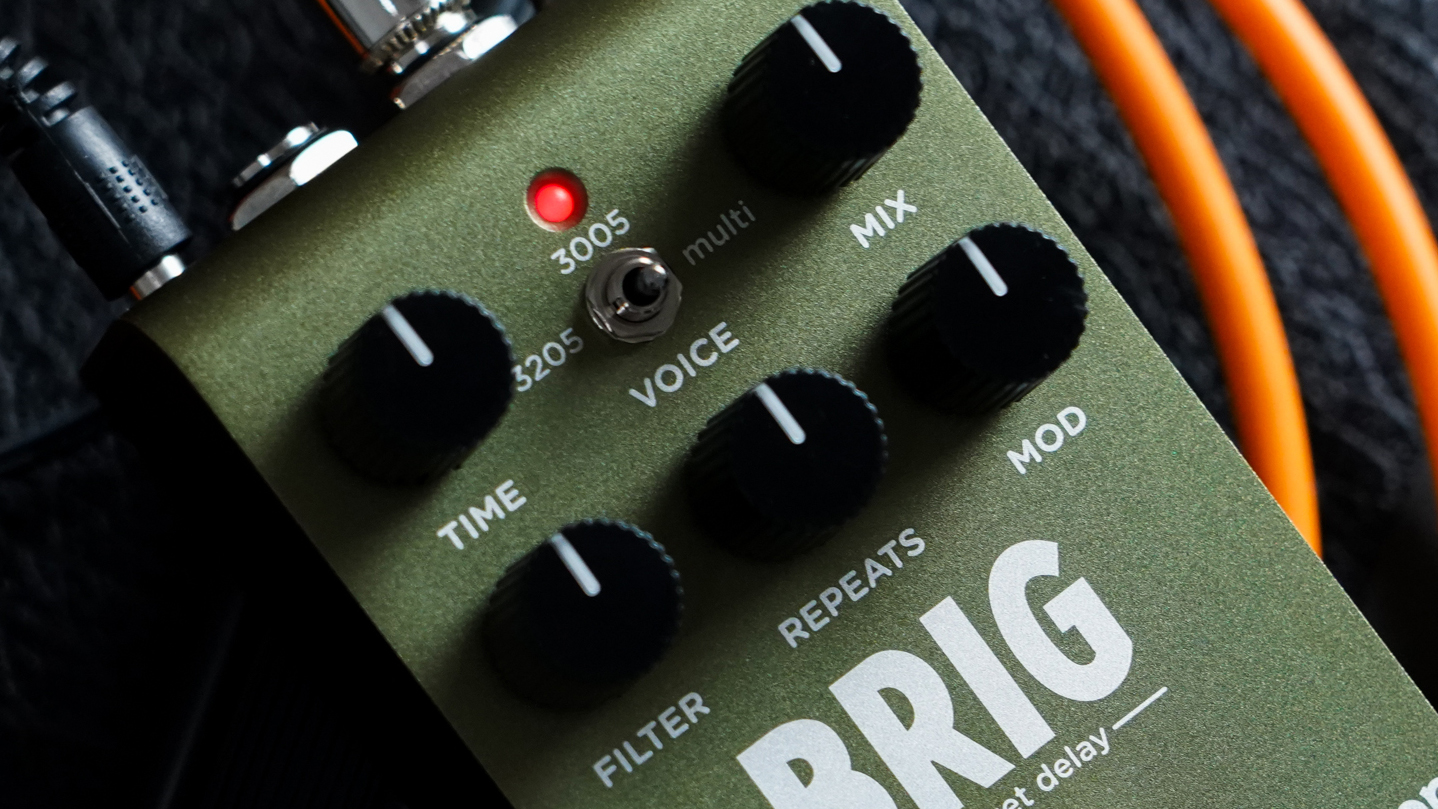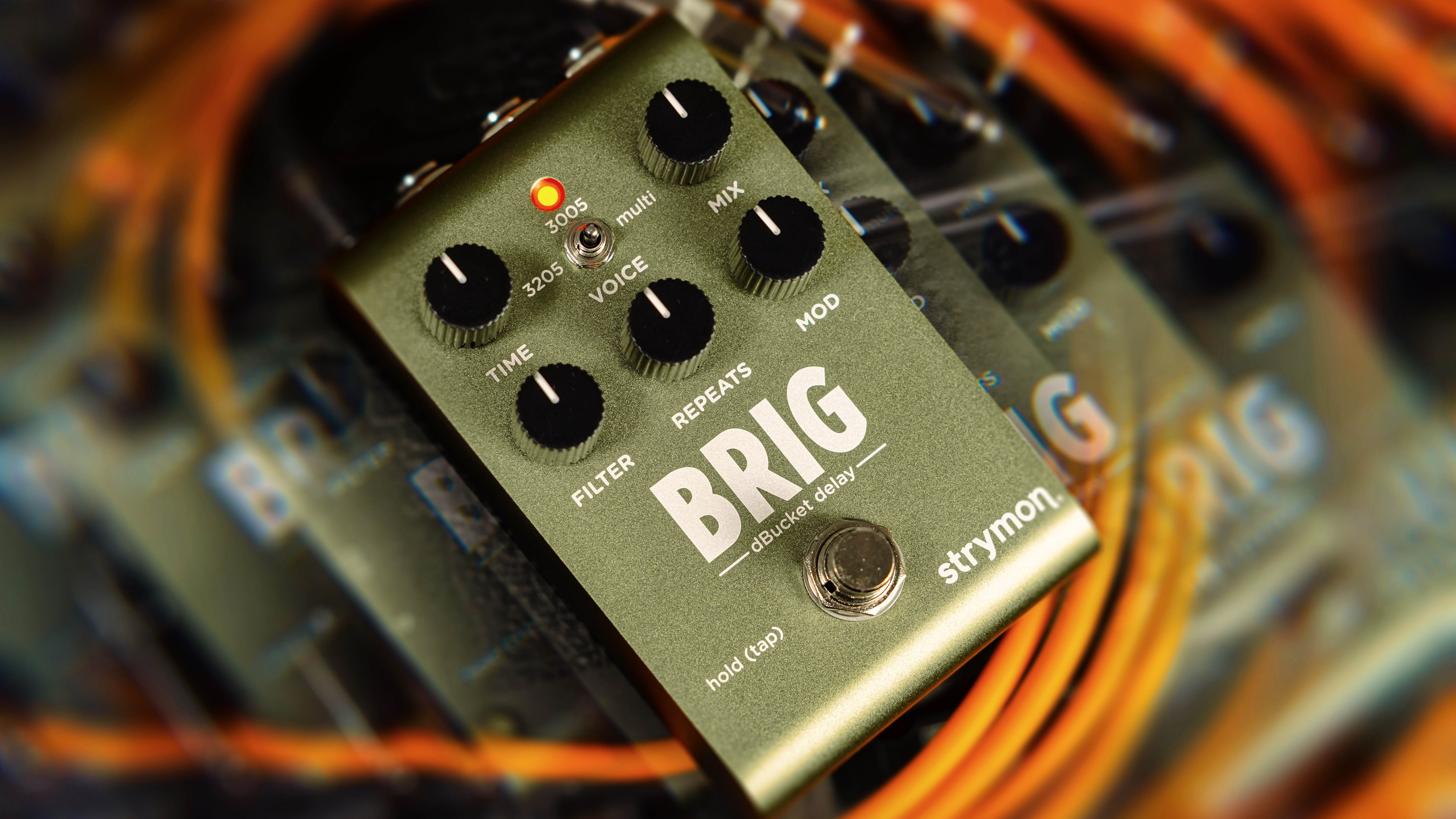MusicRadar Verdict
The Brig packs a great emulation of Bucket Brigade delay glory into a compact package – and more besides – to give this underrated side of Strymon another chance to shine.
Pros
- +
Great selection of emulated BBD sounds
- +
Easy to use and compact
- +
Multi mode voice creates inspiring sustained sounds
Cons
- -
Holding for tap tempo isn't ideal compared to the Brigadier
- -
No onboard preset without buying an additional footswitch
MusicRadar's got your back
Strymon Brig dBucket Delay pedal: What is it?

It comes as no surprise that Strymon's Cloudburst ambient reverb pedal from earlier this year was indeed a precursor for more compact models from the US digital effects masters. That's potentially great news for guitarists, and bad news for their wallets, but how will these pedals fare in comparison with their larger models?
They're cheaper, but not anywhere near affordable, and in the case of the Brig, they're seemingly replacing a past dual-switch model; the Brigadier. That pedal's absence was notable from the V2 refreshes that saw pedals like the BlueSky, El Capitan and Deco with new processors and features. Now we know why, but Strymon is keen to stress this isn't just a small Brigadier, despite the name and colour connection.
It's strange to us that the Brigadier has been somewhat of a dark horse for the company; bucket brigade delay is hardly a niche interest in the effects world and it was a superb digital rendering of an analogue world. Without the Instagrammable pizzaz and unique algorithmic wow factor of the company's more ambient-friendly effects it was up to a pair of pros – Tom Bukovac and Guthrie Trapp – to sing its praises. Meanwhile, its El Capitan tape echo and Flint reverb emulation pedals continue to steal the limelight.
One of the distinct features of Strymon is they're not emulators of specific units and pedals, while Universal Audio has been very clear about the influences of its own UAFX digital emulations of analogue delay and reverbs. Often, Strymon's propositions are so successful they can inspire reappraisal of an effects type you didn't realise you needed so much. Again, your wallet won't thank you for that. But while the Cloudburst took an algorithm from the company's flagship BigSky reverb and added the new Ensemble modest to create its own distinct combo, the Brig has quite a lot of pressure on its slim shoulders. One of the 12 algorithms on the big box Strymon Timeline notwithstanding, this is Strymon's only bucket brigade delay pedal now. Big expectations, small pedal.

Functionality is improved over Strymon's now discontinued Brigadier with midi and stereo-in and instead of Long, Medium and Short voices we have two named after popular BBD chip types – 3205 and 3005 – and a 'Golden Ratio' mode called Multi. The Filter and Modulation are voiced specifically to the mode you're in, effectively offering you three BBD delay pedals in one compact unit.
The 3205 (an emulation of a single Panasonic MN3205 BBD chip running at five volts) voice has a range of 30ms to 300ms (but it's important to note that's only the Time knob's limit because all three modes offer to up to two seconds of delay time in tap tempo mode) – tailored for doubling delay that fattens up leads (with the Mix at around 9-10 O'clock) and offers slapback to raygun-style sounds. To avoid muddiness with these shorter delays, Strymon designer Pete Celi has explained that Brig uses a wide range of filter responses.
When the Filter control is set to maximum in this voice it's at its brightest. The higher the delay time the more loss you'll get from the repeats, like the real thing. Celi also points out that for some of the popular 3205 BBD chip delay pedals (including the Boss DM-2) the Filter is voiced at the equivalent of around 10 o'clock on the Brig.

The 3005 voice (100ms to 1 sec) emulates two BBD chips running at 15-volts for higher headroom and therefore cleaner repeats. While this mode is less distorted compared to the 3205's as a result, Strymon notes it has more of the 'white noise' that becomes part of the BBD experience with longer delay times. But this is part of the gritty analogue vibe and voodoo can be taken out of the equation with the Filter control set past 2 O'clock. An example of how digital emulation can bring an added dimension to its influence.
Let's say those modes are pretty much classic BBD territory, with Strymon seasoning (and we'll get to the modulation side soon). The Multi mode is a bit more curveball by comparison. Here there are two cross-coupled clean delay lines that interact in the golden ratio (1.618) timing. And things can get pretty trippy and complex here. Shoegazers assemble!
The one-switch Brig's case text points out that players need to hold for tap tempo. Any analogue delay pedal user will know that when you set your delay time with a tap tempo switch a pitch shifting occurs from any repeats that are left as you issue the command for a different rate. Hence, warbly sounds that are not always desired – especially onstage. While the repeat controls of the Brig behave like an analogue pedal with pitch shifting when you adjust them, entering tap tempo mode freezes the clock for the player while processing – resulting in no unwanted tap tempo adjustment sounds. It's the refinement of digital emulation again. The set tempo also remains even if you change between the three modes.
Strymon Brig dBucket Delay pedal: Performance and verdict

The modulation adds a sense of width to slapback sounds in the 3205 mode, moving into vibrato from chorus territory as the rate moves up on the Mod control from about 2 o'clock onwards
There are no secondary functions of any controls here to learn; Strymon has successfully fitted a lot of functionality into the Brig's compact dimensions. The depth and rate controls for modulations on the Timeline and Brigadier Modulation are not featured here, instead there's a Mod control to streamline things on the control side, but as usual with Stymon it's deceiving when it comes to what's going on under the hood.
The modulation adds a sense of width to slapback sounds in the 3205 mode, moving into vibrato from chorus territory as the rate moves up on the Mod control from about 2 o'clock onwards. A nice bonus is if players set the Time and Repeats to minimum, with the Mix up, the modulation can be used to make the Brig a chorus pedal, with Strymon's lush clarity making it very usable.
But in its primary role as a delay pedal the Brig excels. For all the talk of white noise, Strymon's signature hi-fi clarity means things never get near to being as gritty and dark as the repeats in the true Bucket Brigade Device Boss DM-101. But it can get swampy in its own way, and there's a lot of appeal in its ability to dial that back for players who need that added clarity onstage. The Brig runs a very assured line between authentic influence and contemporary digital control. Enough warmth to blend with your amp in the desirable BBD way, but the considerations that make the modes excel in their applications.

Comparing to the dBucket mode in the 12-year-old Strymon Timeline proves that it still stands up as one of the best digital emulations of BBD delay even now, and it remains a candidate for the company's best value pedal for me. Especially as a Timeline 2 is still probably some way off. Its dedicated tap tempo switch is also a plus (and more intuitive than the Brig's switch that needs to be held to activate that pressed again once it is set) but the Brig's stands out with the optimised approach to the 3005 and 3205 modes and modulation that gives it a wider, deeper dimension that's very noticeable. It sounds even more like a true BBD delay pedal to our ears in A/B testing. One with appeal for fans of pedals like the DM-2 and Carbon Copy, but one with diallable 'white noise' on longer delays (like the Bucket Loss control on the Brigadier) to suit different tastes and offering more scope in a band mix.

The Cloudburst's limiting caveat for me applies here too; there's no scope for an onboard preset and you'll need to invest in one Strymon's optional switches ($49). The cheapest of these, the MiniSwitch, can be set to recall a single saved favourite preset, activate infinite repeats for your crescendo moment at the end of a song or serve as an external tap tempo. I think it's a worthwhile investment if this is your main delay pedal – but it adds on financial outlay, and footprint for the pedalboard. The Brigadier didn't offer presets as stock either but could provide infinite repeats out of the box.
Pete Celi's new Multi Voice mode for the Brig is also a draw here for creativity; blurring the lines with a reverb-like wash for sustained parts in higher repeat settings. Not the kind of sounds you'd expect from an analogue-style delay, but a very welcome option that has applications from atmospherics to sustained lead guitar work. The result is a compact pedal with three modes that set a new standard for digital BBD emulation.
MusicRadar verdict: The Brig packs a great emulation of Bucket Brigade delay glory into a compact package – and more besides – to give this underrated side of Strymon another chance to shine.
Strymon Brig dBucket Delay pedal: Hands-on demos
Peach Guitars
Andertons
Strymon
Antoine Michaud
Leon Todd
Strymon Brig dBucket Delay pedal: Specifications

- TYPE: Digital delay emulating a Bucket Brigade Device pedal with three modes
- ORIGIN: USA
- CONTROLS: Time, Voice mini-toggle, Filterm Repeats, Mod, Bypass / tap tempo
- FEATURES: TRS MIDI/expression jack allows for external control via an expression pedal, full stereo inputs and outputs via TRS jacks, MIDI integration (also via USB-C from computer) to enable 300 onboard presets, real-time parameter control, artifact-free tap tempo
- BYPASS: True or buffered
- POWER: 9V centre-negative power supply (250mA minimum draw, PSU not included)
- CONTACT: Strymon

Rob is the Reviews Editor for GuitarWorld.com and MusicRadar guitars, so spends most of his waking hours (and beyond) thinking about and trying the latest gear while making sure our reviews team is giving you thorough and honest tests of it. He's worked for guitar mags and sites as a writer and editor for nearly 20 years but still winces at the thought of restringing anything with a Floyd Rose.
Brace yourself: Bryan Adams didn’t buy his first real six-string in a five and dime
“Nobody listens to one genre. I literally don’t know anybody who listens to one genre. You can be a fan of so many different artists at once”: Laufey on what Gen Z can teach the rest of us about how to appreciate music
Bon Iver - ranked: from Sable, Fable to For Emma, Forever Ago










